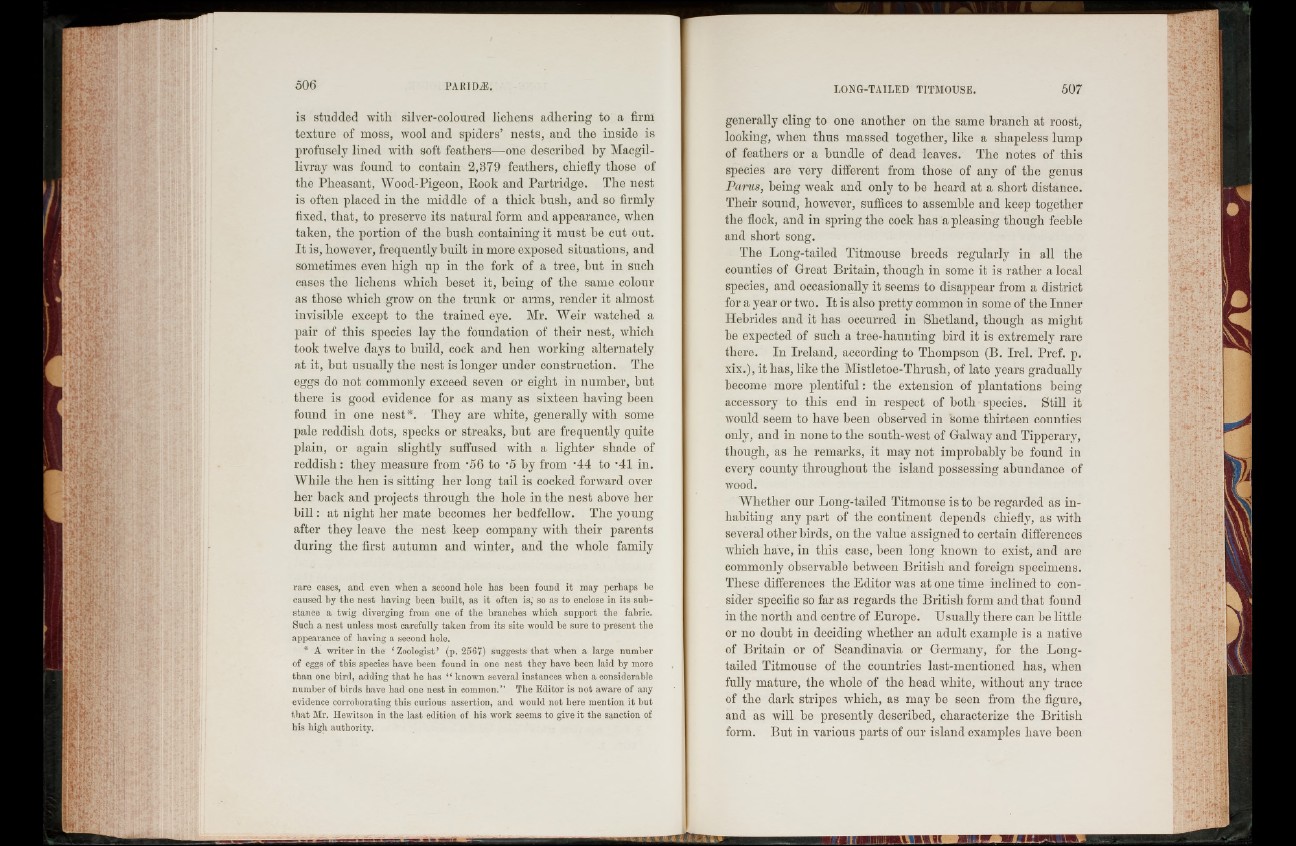
is studded with silver-coloured lichens adhering to a firm
texture of moss, wool and spiders’ nests, and the inside is
profusely lined with soft feathers—one described by Macgil-
livray was found to contain 2,379 feathers, chiefly those of
the Pheasant, Wood-Pigeon, Rook and Partridge. The nest
is often placed in the middle of a thick hush, and so firmly
fixed, that, to preserve its natural form and appearance, when
taken, the portion of the bush containing it must be cut out.
I t is, however, frequently built in more exposed situations, and
sometimes even high up in the fork of a tree, hut in such
cases the lichens which beset it, being of the same colour
as those which grow on the trunk or arms, render it almost
invisible except to the trained eye. Mr. Weir watched a
pair of this species lay the foundation of their nest, which
took twelve days to build, cock and hen working alternately
at it, hut usually the nest is longer under construction. The
eggs do not commonly exceed seven or eight in number, hut
there is good evidence for as many as sixteen having been
found in one nest*. They are white, generally with some
pale reddish dots, specks or streaks, but are frequently quite
plain, or again slightly suffused with a lighter shade of
reddish: they measure from ’56 to '5 by from ‘44 to '41 in.
While the hen is sitting her long tail is cocked forward over
her back and projects through the hole in the nest above her
b ill: at night her mate becomes her bedfellow. The young
after they leave the nest keep company with their parents
during the first autumn and winter, and the whole family
rare cases, and even when a second hole has been found it may perhaps be
caused by the nest having been built, as it often is, so as to enclose in its substance
a twig diverging from one of the branches which support the fabric.
Such a nest unless most carefully taken from its site would be sure to present the
appearance of having a second hole.
* A writer in the ‘ Zoologist’ (p. 2567) suggests that when a large number
of eggs of this species have been found in one nest they have been laid by more
than one bird, adding that he has “ known several instances when a considerable
number of birds have had one nest in common.” The Editor is not aware of any
evidence corroborating this curious assertion, and would not here mention it but
that Mr. Hewitson in the last edition of his work seems to give it the sanction of
his high authority.
generally cling to one another on the same branch at roost,
looking, when thus massed together, like a shapeless lump
of feathers or a bundle of dead leaves. The notes of this
species are very different from those of any of the genus
Parus, being weak and only to be heard at a short distance.
Their sound, however, suffices to assemble and keep together
the flock, and in spring the cock has a pleasing though feeble
and short song.
The Long-tailed Titmouse breeds regularly in all the
counties of Great Britain, though in some it is rather a local
species, and occasionally it seems to disappear from a district
for a year or two. I t is also pretty common in some of the Inner
Hebrides and it has occurred in Shetland, though as might
be expected of such a tree-haunting bird it is extremely rare
there. In Ireland, according to Thompson (B. Irel. Pref. p.
xix.), it has, like the Mistletoe-Thrush, of late years gradually
become more plentiful: the extension of plantations being
accessory to this end in respect of both species. Still it
would seem to have been observed in some thirteen counties
only, and in none to the south-west of Galway and Tipperary,
though, as he remarks, it may not improbably be found in
every county throughout the island possessing abundance of
wood.
Whether our Long-tailed Titmouse is to be regarded as inhabiting
any part of the continent depends chiefly, as with
several other birds, on the value assigned to certain differences
which have, in this case, been long known to exist, and are
commonly observable between British and foreign specimens.
These differences the Editor was at one time inclined to consider
specific so far as regards the British form and that found
in the north and centre of Europe. Usually there can he little
or no doubt in deciding whether an adult example is a native
of Britain or of Scandinavia or Germany, for the Longtailed
Titmouse of the countries last-mentioned has, when
fully mature, the whole of the head white, without any trace
of the dark stripes which, as may be seen from the figure,
and as will be presently described, characterize the British
form. But in various parts of our island examples have been